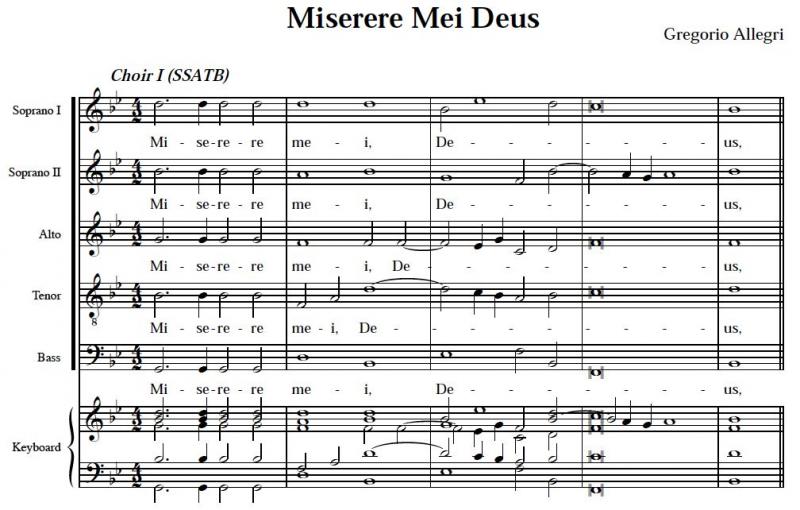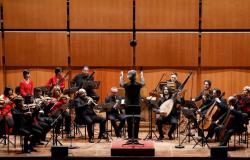Rome, Sistine Chapel
Good Friday 1630
The Pope, Urban VIII, knelt down for the last psalm. He was tired and distracted, his mind busy by the countless palace intrigues. The rites of the Holy Week were drawing to a climax and a profound uneasiness was wounding his bowels. He closed his eyes, grateful that the Tenebrae Service foresaw the extinction of a candle at each psalm. The only one still burning had just carried behind the altar, symbolizing the death of Christ. The near-total darkness was cool against his burning cheeks. His thoughts were still overlapping, pursuing political and economic calculations, preventing his soul to surrender in prayer. He didn't even hear the first notes of the Miserere, and when the young and vibrant castrato's voice began its climb to the sky, carrying with it all the present' souls, Urban VIII was taken aback. Ashamed of the inevitable evils of power, he opened his eyes and looked at the judging Christ above his head. The flickering candlelight underlined the severe figure making it almost alive. Have mercy upon me, O God... Have mercy...
I know, this is fiction. But I wonder what really happened that day to convince the Pope to prohibit the use of Allegri's Miserere outside the Sistine Chapel at the appointed time, calling for excommunication for anyone who sought to copy the work?
Allegri's Miserere is quite a simple composition and much of its impact depends on the conditions of performance, especially on the acoustic. There are five identical sections in the music, except for the second half of the final verse where the solo group and the main choir at last join up. The musical effect is created by Allegri's use of discords – obtained with a series of suspensions - and by embellishments of the soprano vocal line, which take the solo treble to a high C. The text is the famous King David's psalm – the Psalm 51 - probably the most penitential of all, traditionally sung in a Catholic rite called Tenebrae - that doesn't exist any more - and usually took place during the last three days of Holy Week.
This song enjoyed almost immediate popularity with its soaring soprano parts – sung for centuries by castrati – and compelling melodic style. The Papacy shrewdly heightened its reputation, realising that it owned a composition of exceptional appeal, by refusing to allow any copy to leave the Sistine Chapel.
 In spite of this, by 1770 three copies were known to exist. One was owned by the King of Portugal; another was in the possession of Giovanni Battista Martini; and a third was kept in the Imperial Library in Vienna. The way this copy arrived in Vienna contributes to the mystique that has come to surround this work. The Emperor Leopold I (1640-1705) having heard of the piece from dignitaries visiting Rome, ordered to his ambassador to the Vatican to ask the Pope for a copy of the work in order to perform it in the royal chapel. The Pope eventually obliged, but when the work was performed in Vienna, it was so disappointing that the Emperor believed he had been deceived, and a lesser work sent to him instead. He complained to the Pope, who fired his Maestro di Cappella. The unfortunate man pleaded for a papal audience, explaining that the beauty of the work owed to the special performance technique used by the papal choir, which could not be set down on paper. The Pope, understand nothing of music, granted the man permission to go to Vienna and make his case, which he did successfully, and was rehired.
In spite of this, by 1770 three copies were known to exist. One was owned by the King of Portugal; another was in the possession of Giovanni Battista Martini; and a third was kept in the Imperial Library in Vienna. The way this copy arrived in Vienna contributes to the mystique that has come to surround this work. The Emperor Leopold I (1640-1705) having heard of the piece from dignitaries visiting Rome, ordered to his ambassador to the Vatican to ask the Pope for a copy of the work in order to perform it in the royal chapel. The Pope eventually obliged, but when the work was performed in Vienna, it was so disappointing that the Emperor believed he had been deceived, and a lesser work sent to him instead. He complained to the Pope, who fired his Maestro di Cappella. The unfortunate man pleaded for a papal audience, explaining that the beauty of the work owed to the special performance technique used by the papal choir, which could not be set down on paper. The Pope, understand nothing of music, granted the man permission to go to Vienna and make his case, which he did successfully, and was rehired.
Another famous anecdote concerning the Miserere involves the 12-year-old Mozart. On December 1769, Leopold and Wolfgang left Salzburg and set out for a 15-month tour of Italy and arrived in Rome on April 1770, just in time for Easter. As with any tourist, they visited St. Peter's to assist at the Wednesday Tenebrae service and to hear the famous Miserere sung at the Sistine Chapel. Upon arriving at their lodging that evening after the service, Mozart sat down and wrote out by heart the entire piece. On Good Friday, he returned to hear the piece again and make a few minor corrections. Leopold told of Wolfgang's achievement in a letter to his wife dated April 14, 1770 (Rome):
"…You have often heard of the famous Miserere in Rome, which is so greatly prized that the performers are forbidden on pain of excommunication to take away a single part of it, copy it or to give it to anyone. But we have it already. Wolfgang has written it down and we would have sent it to Salzburg in this letter, if it were not necessary for us to be there to perform it. But the manner of performance contributes more to its effect than the composition itself. Moreover, as it is one of the secrets of Rome, we do not wish to let it fall into other hands…."
Wolfgang and his father then travelled on to Naples but were called back by the Pope himself. Returning to Rome a few weeks later to attend a papal audience Mozart, instead of being excommunicated, was rewarded for his great talent.
Thanks to young Mozart the Allegri's Miserere was finally freed, after 150 years of captivity in the Sistine Chapel, and we can now enjoy it in many different renditions.
For my next visit to the Sistine Chapel I have already downloaded on my MP3 my favourite one – Miserere - in which the soaring part is sung by a boy soprano, a good sample of what would have been the actual castrati's performance.
With this soundtrack in your ears you can pretend to be alone in front of Michelangelo's masterpiece and, following the high notes, make your visit to the Sistine Chapel an heavenly experience.




















